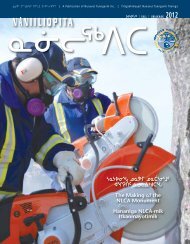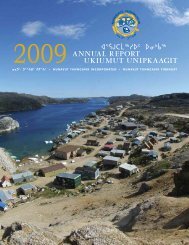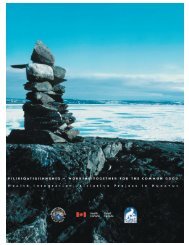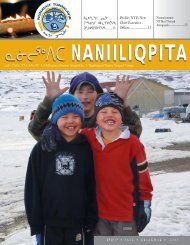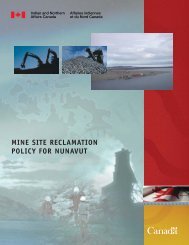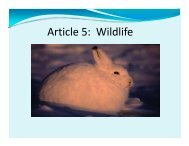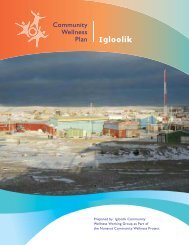Ensuring a Sustainable and Humane Seal Harvest - Nunavut ...
Ensuring a Sustainable and Humane Seal Harvest - Nunavut ...
Ensuring a Sustainable and Humane Seal Harvest - Nunavut ...
You also want an ePaper? Increase the reach of your titles
YUMPU automatically turns print PDFs into web optimized ePapers that Google loves.
The Observation of the <strong>Seal</strong> <strong>Harvest</strong><strong>Seal</strong> Fishery Observation Licences have been required since 1977. DFO states that“these licences are designed to ensure an orderly seal harvest <strong>and</strong> arose as a result ofdisruptive confrontations between sealers <strong>and</strong> protesters,” <strong>and</strong> that “conditions on thelicences <strong>and</strong> the grounds for issuing them have been modified to reflect legal advice <strong>and</strong>still ensure that sealers can concentrate on killing seals in a humane manner.” 45 In 2006,DFO issued 73 seal fishery observation licences, up from 60 in 2005 <strong>and</strong> 42 in 2004.These numbers show increasing interest in observing the harvest. Committee memberstravelled to observe the seal harvest in April 2007 <strong>and</strong> witnessed a well-managed fishery,probably the most actively monitored professional harvesting activity in the country.Members appreciated the professionalism of the staff enforcing regulations, includingmembers of the Canadian Coast Guard, the RCMP, the Sureté du Québec, <strong>and</strong> DFOFisheries Officers. More importantly, Committee members observed an on-siteexamination of carcasses of harvested seals by a qualified licensed wildlife veterinarianwho confirmed the humane killing of the examined animals.Observation of the seal harvest was discussed at the Annual Forum on <strong>Seal</strong><strong>Harvest</strong> Management held in St. John’s, Newfoundl<strong>and</strong> <strong>and</strong> Labrador in November 2005.The Committee agrees with the participants at the forum who expressed broad support fora more effective management of observers. In particular, the issues of a safe distancebetween seal harvesters <strong>and</strong> observers, number of observers, <strong>and</strong> observer training werediscussed. Several harvesters have since told the Committee that their work has becomemore difficult <strong>and</strong> dangerous because of the risk of confrontation with the observers, whichis compounded by the harsh environment. DFO has established that the buffer zonebetween observers <strong>and</strong> the seal harvest is 10 metres or more. This means an observermust stay at least 10 metres away from where harvesting is taking place, but notnecessarily away from the seals. In the Committee’s view, the buffer zone should beincreased to maximize everyone’s safety <strong>and</strong> to ensure order in the harvest. This could bedone without sacrificing the quality of the observation. An observer equipped with modernbinoculars would have little difficulty observing harvesting activities at a distance of100 metres. 46 An exception could be made for licensed qualified veterinarians. TheCommittee also strongly believes that for observers to be safe in areas where rifles areused, the buffer zone should be at least 400 metres . 47454647Fisheries <strong>and</strong> Oceans Canada, 2005 <strong>Seal</strong> Forum Proceedings, accessed on 10 April 2007 athttp://www.dfo-mpo.gc.ca/seal-phoque/reports-rapports/2005-forum/2005-forum_e.htm.For example, high optical quality 8x42 binoculars with a 7 degrees angular field of view would have a linear field ofview of 12 metres at a distance of 100 metres.This is somewhat analogous to hunting practices across the country. For example, the Nova Scotia HuntingRegulations specifies that no person shall at any time hunt, take or kill, or attempt to hunt, take or kill wildlife ordischarge a weapon within 804 metres of a school; discharge a firearm loaded with a rifle cartridge, single ball, orslug within 402 metres of a dwelling, playground, golf course, athletic field, woods operation, place of business, orpublic building other than a school. In Ontario, townships <strong>and</strong> municipalities have by-laws restricting the discharge19





